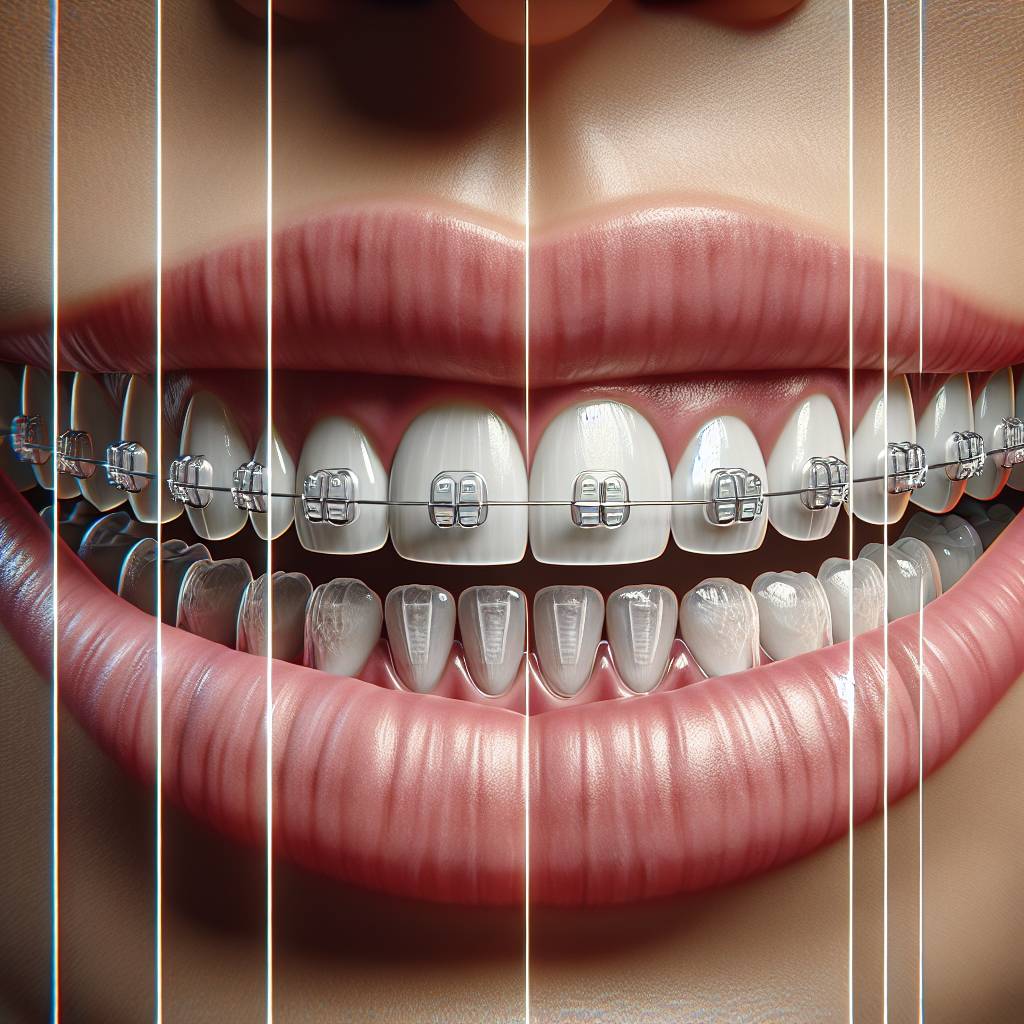Invisalign is a popular option for people who want to straighten their teeth without the hassle of traditional braces. But how long does it take Invisalign to straighten teeth? The answer can vary depending on the severity of your misalignment and whether you follow your Invisalign treatment plan. On average, most people are able to achieve noticeable results in 6-18 months.The length of time required to straighten teeth with Invisalign varies depending on the severity of the individual case. Generally, it takes around 12 to 18 months for most people to complete their Invisalign treatment. However, some cases may take longer or shorter periods of time depending on how complex the case is.
What Factors Affect the Duration of Invisalign Treatment?
Invisalign treatment is a popular choice for those looking to straighten their teeth without the hassle of traditional metal braces. The duration of your Invisalign treatment can vary significantly depending on a variety of factors, such as the complexity of your case and your dedication to wearing the aligners. Here are some of the major factors that can affect how long your Invisalign treatment takes:
1. Complexity of Your Case: The complexity of your case is one of the primary factors in determining how long your Invisalign treatment will take. If you have more severe problems with misalignment or overcrowding, it will take longer for you to achieve the desired results. On the other hand, if you have minor issues with spacing or bite alignment, it may take less time for your teeth to be straightened.
2. Dedication to Wearing Aligners: It is important that you wear your aligners as prescribed by your dentist in order for them to be most effective. This means wearing them for at least 20-22 hours a day and changing them out every two weeks as directed by your dentist or orthodontist. If you are not diligent about wearing them, it can take longer for you to see results from your Invisalign treatment.
3. Proper Care and Maintenance: Proper care and maintenance are essential when using Invisalign aligners in order to get the best results in a timely manner. This means cleaning them after each use and storing them properly when not in use so they do not become damaged or warped from exposure to heat or moisture. Taking these precautions will help ensure that you get the most out of your Invisalign treatment and that it does not take any longer than necessary.
Ultimately, how long it takes for you to complete an Invisalign treatment depends on several factors determined by both yourself and your dentist or orthodontist. With proper care and dedication, however, most people can achieve their desired results within 6-18 months depending on their individual situation.
How Many Aligners Will You Need for Invisalign Treatment?
The number of aligners that you will need for Invisalign treatment depends on the complexity of your orthodontic case and the number of teeth that need to be moved. Generally speaking, most people require between 10 and 30 aligners to complete their treatment. However, some cases may require more, while others may need fewer. Your orthodontist can assess your case and give you a better idea of how many aligners you will need for successful treatment with Invisalign.
Invisalign aligners are designed to move your teeth from their current position into a new one over a period of time. As such, each aligner performs a specific task in order to move your teeth in the desired direction. Each aligner is typically worn for two weeks before being replaced with the next one in the series. The number of aligners needed to complete the treatment is based on how much movement needs to occur in order for your teeth to reach their final positions.
The length of time it takes to complete an Invisalign treatment varies depending on the complexity of the case and the amount of movement required. Most people finish their treatments between 12 and 18 months, although some cases may take longer or shorter depending on their individual needs. During your initial consultation with your orthodontist, they can provide you with a better estimate regarding how many aligners you would need for successful treatment as well as an estimated timeline for completion.
Invisalign is an effective way to straighten teeth without metal brackets or wires, but it does require commitment and patience in order to get results. The number of aligners needed varies from one patient to another depending on their individual orthodontic needs, but most people can expect to go through 10-30 sets before reaching their desired result.
Invisalign Benefits
Invisalign is a modern alternative to traditional braces. It uses a series of custom-made clear plastic aligners to gradually move the teeth into the desired position. This is done without any metal brackets or wires. Invisalign offers many advantages over traditional braces, including virtually invisible treatment, no metal wires or brackets, and faster treatment times.
Discreet Appearance
One of the biggest benefits of Invisalign is its discreet appearance. The aligners are virtually undetectable when worn, so you don’t have to worry about self-consciousness due to the obvious presence of metal braces. This also makes it more comfortable and less likely to cause injury.
Comfort
Unlike traditional braces, Invisalign is made from smooth plastic that fits snugly around your teeth and gums for a comfortable fit that won’t pinch or irritate your skin. The aligners can also be easily removed for brushing and flossing your teeth and eating meals.
Faster Treatment Times
Invisalign can straighten teeth in as little as 6 months compared to 18 months or more with traditional braces. This means you can achieve straighter teeth in a fraction of the time with Invisalign compared to traditional braces. Additionally, since there are no metal wires or brackets, there are fewer adjustments needed throughout treatment which further reduces treatment times.
Easy Maintenance
Since there are no metal wires or brackets with Invisalign, there is less maintenance involved in keeping them clean and free of food particles that can get stuck in traditional braces. Additionally, because they are removable you can brush and floss as normal without having to maneuver around the brackets and wires like with traditional braces.
How Much Does Invisalign Cost for Teeth Straightening?
Invisalign is a popular and effective way to straighten teeth without the need for metal braces. It uses a series of clear, customized aligners to gradually move teeth into the desired position. The cost of Invisalign can vary depending on a number of factors, including the severity of the case, the complexity of treatment, and location. On average, Invisalign costs between $3,500 and $8,500.
The cost will depend on how severe your case is and how long your treatment plan will last. The more complex your case is, the more expensive it will be. Generally speaking, simple cases may only require a few aligners over a short period of time and may fall within the lower end of the cost range. On the other hand, more complex cases may require multiple sets of aligners over a longer period of time and could fall on the higher end of the range or even beyond it.
The cost can also vary by location. Generally speaking, Invisalign is more expensive in larger cities due to higher overhead costs for orthodontists in these areas. Additionally, some orthodontists offer discounts or special offers that can help reduce overall costs significantly. It’s important to do your research and shop around to get an accurate estimate for your particular situation.
In addition to the initial cost of Invisalign treatment, there may also be additional costs associated with follow-up visits or additional aligners if needed throughout treatment. These costs will depend on how often you need to visit your orthodontist as well as any other follow-up treatments that are required during or after treatment is complete.
In general, Invisalign can be an effective way to straighten teeth without needing metal braces. The cost for treatment can vary depending on severity and complexity as well as location but generally falls between $3,500 and $8,500 on average. Additionally there may be other costs associated with follow-up visits or additional aligners throughout treatment which should also be taken into consideration when budgeting for Invisalign treatment.

Does Insurance Cover the Cost of Invisalign Treatment?
Many insurance companies offer coverage for Invisalign treatment, but the amount of coverage can vary widely from one plan to another. In general, most insurance plans will cover some part of the cost of Invisalign treatment, but it is important to check with your specific plan to determine what type of coverage you have. Some plans may only cover a portion of the total cost while others may cover all or most of it. It is best to speak with your insurance provider directly to determine what kind of coverage you have and how much you can expect to receive.
In addition to insurance coverage, there are also other ways that you can save money on your Invisalign treatment. Many dental offices offer discounts or special financing options that can help make the treatment more affordable. Additionally, some dental offices may offer payment plans that allow you to make monthly payments instead of paying for the entire treatment up front.
Ultimately, it is important to speak with your dentist and insurance provider before beginning any type of orthodontic treatment in order to determine what type of coverage you have and what other options are available for making the treatment more affordable. With a little bit of research and planning, you can find a way to make Invisalign treatment fit within your budget.
Common Side Effects of Invisalign Treatment
Invisalign is a popular orthodontic treatment that uses plastic aligners to gradually straighten teeth. While Invisalign is a safe and effective treatment, there are some common side effects that patients should be aware of. The most common side effects include soreness in the mouth, difficulty talking, and pain when eating.
Soreness in the mouth is one of the most commonly reported side effects of Invisalign treatment. This soreness usually occurs when the aligners are first placed in the mouth and can last for several days or weeks as the teeth adjust to the new alignment. To help alleviate this soreness, patients can use an over-the-counter pain reliever or apply an ice pack to the affected area.
Difficulty talking is another common side effect of Invisalign treatment. This is because the aligners can cause a lisp or slurring of words due to their presence in the mouth. Patients may find it helpful to practice speaking with their aligners in place until they become more comfortable with them.
Pain when eating is another potential side effect of Invisalign treatment, especially if patients are not used to wearing aligners while they eat. To help minimize this discomfort, patients should take smaller bites and chew slowly until they become accustomed to wearing their aligners while eating. Additionally, removing the aligners prior to each meal may also help lessen any pain associated with eating while wearing them.
Overall, Invisalign is a safe and effective orthodontic treatment that can help improve smiles and oral health for many individuals. While there are some common side effects associated with this treatment, these can usually be alleviated with simple home remedies such as taking over-the-counter pain medication or using an ice pack on sore areas of the mouth. Additionally, practicing speaking and eating with aligners in place can also help reduce any discomfort associated with these activities while wearing them.
Invisalign: The Most Effective Way to Straighten Teeth?
Invisalign is an increasingly popular orthodontic treatment that has been gaining attention in recent years due to its convenience and effectiveness. Invisalign is an alternative to traditional metal braces, using custom-made clear plastic aligners that are virtually undetectable. The aligners are designed to gradually move the teeth into their desired positions over time with minimal discomfort. This method of straightening teeth has proven to be extremely effective in producing a perfect smile, and has become one of the most popular choices for those looking for an aesthetically pleasing solution.
One of the main benefits of Invisalign is its convenience. Unlike traditional metal braces, which can be uncomfortable and require frequent visits to the orthodontist for adjustments, Invisalign requires only occasional check-ups during treatment. Additionally, the clear aligners can be removed when eating or brushing your teeth, which makes it much easier to maintain good oral hygiene during the treatment process.
In terms of effectiveness, Invisalign has been found to be just as successful as traditional metal braces in producing desirable results. Studies have shown that after completing treatment with Invisalign, patients have experienced improved oral health and a more aesthetically pleasing smile. Additionally, because Invisalign does not require any metal hardware or brackets like metal braces do, there is less risk of damage to gums or other soft tissue during treatment.
Overall, Invisalign is an effective way to straighten teeth without compromising on aesthetics or comfort. It offers many advantages over traditional metal braces while still providing excellent results in terms of both appearance and oral health. If you are looking for a discreet and convenient way to achieve a beautiful smile, Invisalign may be the perfect choice for you.

Conclusion
Invisalign is a convenient and effective way to straighten teeth. The process of aligning teeth with Invisalign takes anywhere from 12-18 months, depending on the severity of your current oral condition. Invisalign works gradually, so over time your teeth will become straighter and more aesthetically pleasing. It is important to follow the instructions provided by your orthodontist and wear your aligners for at least 22 hours per day in order to ensure that treatment is successful. With regular visits to the orthodontist and good oral hygiene habits, you can achieve a beautiful smile with Invisalign.
Overall, Invisalign is an excellent choice for patients looking for a more discreet and comfortable way to straighten their teeth. It provides many advantages over traditional braces, such as not having food restrictions, being able to clean your teeth easily, and being able to remove them when necessary. With proper care and dedication, you can have a straighter smile in no time!

